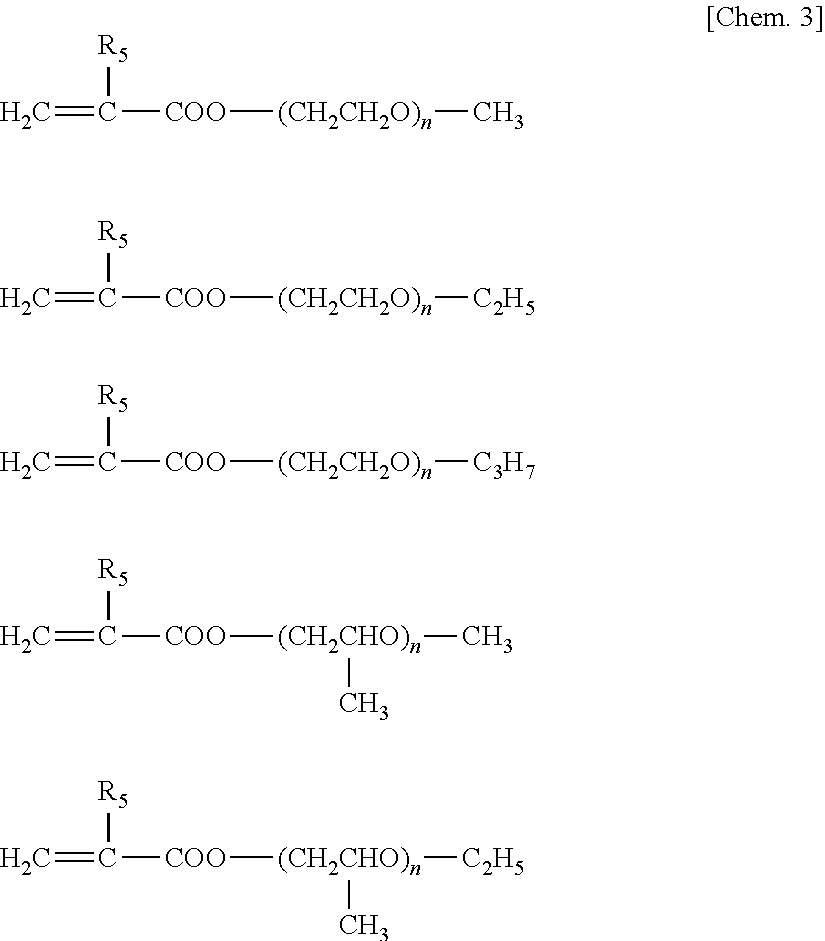Battery separator and battery using the same
a battery separator and separator technology, applied in the direction of cell components, final product manufacturing, sustainable manufacturing/processing, etc., can solve the problems of increasing the internal resistance of the battery, the isal pressure for maintaining the electrical connection between the separator and each electrode cannot be sufficiently applied to the electrode surface, and the battery container of the laminated-film type cannot be used to maintain the electrical connection, etc., to achieve excellent oxidation resistance and excellent adhesiveness to the electrodes
- Summary
- Abstract
- Description
- Claims
- Application Information
AI Technical Summary
Benefits of technology
Problems solved by technology
Method used
Image
Examples
reference example 1
(Preparation of Electrode Sheets)
[0109]Eighty-five parts by weight of lithium cobalt oxide (Cellseed C-10, manufactured by Nippon Chemical Industrial Co., Ltd.) as a positive-electrode active material was mixed with 10 parts by weight of acetylene black (Denka Black, manufactured by Denki Kagaku Kogyo K.K.) as a conduction aid material and 5 parts by weight of a vinylidene fluoride resin (KF Polymer L #1120, manufactured by Kureha Chemical Industry Co., Ltd.) as a binder. This mixture was slurried with N-methyl-2-pyrrolidone so as to result in a solid concentration of 15% by weight. This slurry was applied in a thickness of 200 μm to an aluminum foil having a thickness of 20 μm (current collector) and vacuum-dried at 80° C. for 1 hour and then at 120° C. for 2 hours. The coated foil was pressed with a roller press to prepare a positive-electrode sheet having an active-material layer with a thickness of 100 μm.
[0110]Eighty parts by weight of mesocarbon microbeads (MCMB 6-28, manufact...
reference example 2
(Production of Porous Polyethylene Resin Film)
[0111]Fifteen parts by weight of ultrahigh-molecular polyethylene having a weight-average molecular weight of 1,000,000 (melting point, 137° C.) was evenly mixed with 85 parts by weight of liquid paraffin to obtain a slurry. This slurry was melt-kneaded with a twin-screw extruder at a temperature of 170° C. and extruded through a coathanger die into a sheet having a thickness of 2 mm. The resultant sheet was cooled while being taken off with a roll. Thus, a gel sheet having a thickness of 1.3 mm was obtained. This gel sheet was subjected at a temperature of 123° C. to simultaneous biaxial stretching in which the sheet was stretched in the MD (machine direction) 4.5 times and in the TD (transverse direction) 5 times. Thus, a stretched film was obtained.
[0112]Decane was used to remove the liquid paraffin from the stretched film. Thereafter, the film was dried at room temperature to remove the decane. Thus, a porous film was obtained. The p...
reference example 3
(Preparation of Reactive Polymer)
[0121]Into a three-necked flask having a capacity of 500 mL and equipped with a reflux condenser were introduced 84 g of methyl methacrylate, 2.0 g of 4-hydroxybutyl acrylate, 14.0 g of 2-methoxyethyl acrylate, 25 g of ethyl acetate, and 0.20 g of N,N′-azobisisobutyronitrile. While nitrogen gas was being introduced, the contents were stirred and mixed for 30 minutes and then heated to 70° C. to initiate radical polymerization. At the time when about 1 hour had passed, an increase in the viscosity of the reaction mixture was observed. Thereafter, while ethyl acetate was being added to the reaction mixture, the temperature was kept almost constant and the polymerization was continued for further 8 hours.
[0122]After completion of the reaction, the reaction mixture obtained was cooled to 40° C., and ethyl acetate was added thereto. The contents were stirred and mixed until the mixture became wholly homogeneous. Thus, an ethyl acetate solution of a reacti...
PUM
| Property | Measurement | Unit |
|---|---|---|
| thickness | aaaaa | aaaaa |
| thickness | aaaaa | aaaaa |
| thickness | aaaaa | aaaaa |
Abstract
Description
Claims
Application Information
 Login to View More
Login to View More - R&D
- Intellectual Property
- Life Sciences
- Materials
- Tech Scout
- Unparalleled Data Quality
- Higher Quality Content
- 60% Fewer Hallucinations
Browse by: Latest US Patents, China's latest patents, Technical Efficacy Thesaurus, Application Domain, Technology Topic, Popular Technical Reports.
© 2025 PatSnap. All rights reserved.Legal|Privacy policy|Modern Slavery Act Transparency Statement|Sitemap|About US| Contact US: help@patsnap.com



